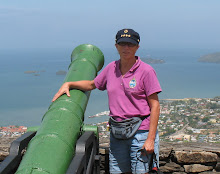We arrived at Little Bay after an uneventful crossing at about 3 p.m. WW went ashore to clear us in and met taxi driver George Christian who would give us a tour for $100 US. We were to meet him at 10 the next morning. On his way back to Django, WW asked the couple on Tom Tom, our nearest neighbours, whether they would care to join us. They were, alas, leaving early the next day. In the end, however, the day dawned bright and beautiful and Nick and Anna came to ask if they could, after all, come with us. Reducing the cost from $50 per person to $25 per person made WW a happy tourist.
George was terrific. He drove us up from Little Bay, which, for reasons I cannot fathom, the government is trying to turn into the new capital. Not more than a mile or two away is the town of Brades, probably the larges settlement on the island and home to the administrative buildings. Now, why would you go to the fuss, bother and expensive of moving everything a mile or so? Beats me. George said I was not the only person to feel that way.
I confess, I was a little concerned about the content of the tour when George, a dour but knowledgeable fellow, began by pointing our such notable sites as “the insurance broker”, “the hair salon”, “the school”, “the grocery store”. In fairness, though, there's not much to point out in a small town other than those things. Once we left town, however, the tour picked up. We stopped somewhere between (I think) Soldier Ghaut and Runaway Ghaut (rivers), to sample water from a stream running down the heavily wooded hillside to the road. A faucet had been installed. George told us that anyone who drank the water was “destined to return to the island.” Works for me. I drank both from the stream and the faucet.
The island is very beautiful with many gorgeous houses in carefully groomed grounds. When I told George I thought the island very lovely, he grunted. “You should have seen it before.”
I came to a small appreciation of the love/hate relationship he has with the volcano. It has ruined a lush and beautiful landscape...bad for locals. It is a huge tourist attraction...good for taxi drivers.

Volcanic mud, ash, and debris accumulated to fill Old Road Bay.
He drove us down to Old Road Bay, as was. The volcanic gloop (this volcano specializes in mud, ash and debris it picks up on the way down, and pyroclastic flows of steam and hot rocks; it does not do lava) that flowed down entirely filled the bay. The cruise ships used to anchor here and send their guests in on their boats. At one point, George looked down and said, “There used to be 20 feet of water here.” The golf course is 15 feet under. It beggars the imagination, even standing on it. We saw a small cottage to one side of the flow. Oh, beg pardon, not a small cottage, the second floor of quite a large house.

A house, buried up to its second floor in compacted volcanic goo.
(By the way, I forgot my camera for this trip. Doh. The photos were sent to me by the very kind and obliging Nick and Anna. They are a delightful young couple from the UK taking a six month sabbatical from life and work and everything to sail the islands.)
George walked us over the several hundred meters of new land that used to be a bay. By a small pond, he picked up a stone and pitched it in. It floated. We came away with nice lumps of pumice to keep our feet pretty.
Then he took us up Garibaldi Hill, a very steep climb that took about 20 minutes. We were all warm and puffing by the time we crested the rise. And there, spread before us, was Plymouth. Abandoned. Crumbling. The roofs have gone because, as George explained, the ash ate through the nails holding on the shingles. If a great hand had taken aim, it could not have done a better job of totally engulfing the city.

George pointed out the Air Studio building and said George Martin still comes to the island, was, in fact, there as he spoke.
Then it was up to the Montserrat Volcano Observatory (MVO) for spectacular views of the volcano's north side.

The Soufriere Hills Volcano seen from the MVO.
There we met a man from St-Jean-sur-Richelieu who has bought a house nearby. (We drove by it; a lovely seaside estate on Breackweck Point.) He fell in love with the island a few years ago, bought land and intended to build until an aged neighbour had to sell. He got the house, he says, for half the asking price. The volcano is a non-issue, he says. When I mentioned last year, he threw his hands up in a most Gallic gesture and agreed, last year was bad, terrible, awful.
George took us to get some groceries then delivered us back to Little Bay where we had lunch in the tiny beach bar (which is still able to crank out boat-shaking decibels until 3 or 4 in the morning). We sat at the beautiful mahogany bar, donated by George Martin from his house. Around it are little brass nameplates: Paul McCartney, Sting, Mick Jagger, Stevie Wonder, Jimmy Buffet. Choose your superstar.
The four of us returned to our dinghies and bade each other farewell and fair winds.


































